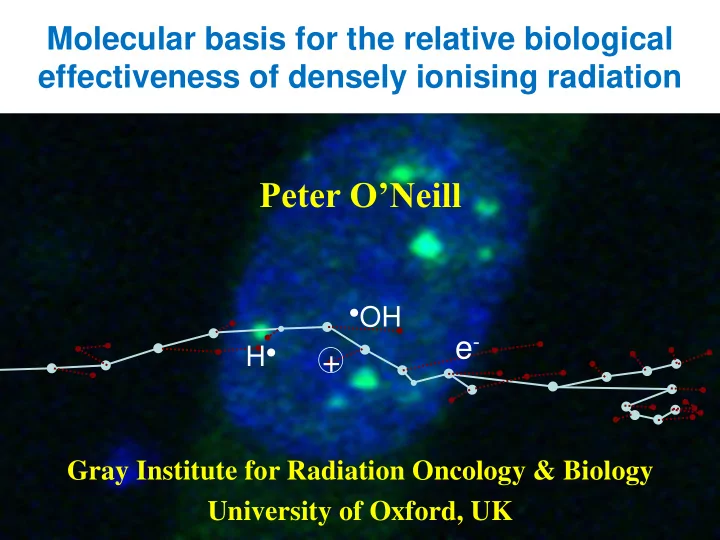

Molecular basis for the relative biological effectiveness of densely ionising radiation Peter O’Neill ● OH e - H ● + Gray Institute for Radiation Oncology & Biology University of Oxford, UK
Spatial distribution of events in cells Track structure defines spatial distribution of energy deposition events -heterogeneous and homogenous Chemistry defines types of lesions and yields -oxygen effects Sub-cellular distribution of damage defined by ionisation density of the radiation - clusters of lesions (nm scale), clusters of DSB ( m m scale), random distribution Distribution of DSB and clustered damage between cells dependent on - the radiation dose for sparsely ionising radiation - the fluence for densely ionising radiations
Damage complexity is largely dependent on ionisation density of the radiation Clustered damage 30-40% low-LET = complex Simple DSB 90% high-LET = Complex DSB complex 100 90 80 low LET high LET 70 percentage of total 60 50 40 30 Nikjoo, O’Neill, Goodhead, Terrissol, 20 Int. J. Radiat. Biol ., 71, 467-483 (1997); 10 Friedland et al., Int. J. Radiat. Biol., early on 0 or more 1 2 3 line (2011) number of lesions in cluster
Maintaining Genomic Stability homologous Replication recombination errors Exogenous chemical species clustered DNA Simple euchromatin damage DSB + Free DSB Radicals heterochromatin Complex base damage DSB SSB base non-homologous excision Ionising end joining Radiation repair
Deficiency in DNA damage repair: RBE of ~1 60 Co MO59K ■ ■ 60 60 Co K Co K □ 60 Co J MO59J- inactive ● N-ions K Surviving fraction DNA-PKcs ● N-ions J 60 Co MO59J 14 7+ N MO59J 14 7+ N MO59K Inactivation of the major DNA 2 4 6 8 DSB repair pathway, leads to dose/Gy similar radiosensitivity - independent of LET. Lind et al Radiation Research 160, 366-375 (2003)
IR-induced DNA damage IR DSB Non-DSB Base SSB clustered damage damage simple complex 2 or more damages within 1-2 helical turns of the DNA Non-homologous end joining Base excision repair Homologous recombination SSB repair Single strand annealing
IR-induced DSB – different types one-ended DSB double-ended DSB -replication induced DSB -prompt DSB -frank DSB Homologous recombination Non-homologous end joining
Variation in dynamics of DSB loss following irradiation 1.2 Relative Yield of DSBs 56Fe 56 Fe ion 1 Double strand breaks g -radiation gamma-… 0.8 a 0.6 0.4 g 0.2 0 0 4 8 12 16 20 24 Time (h) g H2AX PFGE Anderson, Harper , Cucinotta, O’Neill. Jenner, de Lara, O'Neill,Stevens, Radiat. Res. 174, 195-205 (2010) Int. J. Radiat. Biol , 64, 265-273 (1993) Do differences in repair kinetics reflect DSB of different complexity? Different sub-sets of proteins recruited to some DSB?
1Gy 56 Fe ions (1 GeV/nu) – DSB detection by g H2AX 0.5 h 24 h 6 h Tracks of DSB ( g H2AX foci) remain at longer times - persistence of DSB reflects complexity of DSB Jakob et al. NAR 39, 6489 (2011); Jeggo et al, EMBO J ., 30, 1079 (2011) Heterochromatin/euchromatin?
Damage complexity- all damage substrates are not the same Very Cannibalise complex Simple Primer complex Write off extension damage damage from other car damage repair
Dynamics of repair of DSB induced in cells irradiated at 37 ºC PFGE % DSB remaining γ -H2AX 100 Complex DSB and/or 50 heterochromatin DSB 120 180 60 Time (min) g H2AX as quantitative marker of DSB? Role of heterochromatin?
DSB Repair in Absence of DNA-PK cs : 56 Fe % of cells with RAD 51 tracks 50 % of cells with gamma 100 g H2AX (1 Gy) (1 Gy) RAD51 45 90 40 80 H2AX tracks 35 70 60 30 50 25 40 20 30 15 20 10 10 5 0 0 0 4 8 12 16 20 24 0 4 8 12 16 20 24 M Inactive DNA-PKcs Time (h) Time (h) M Active DNA-PKcs H complex DSBs clustered damage Some clustered Slow NHEJ damage converted to Repair DSBs at replication +DNA-PKcs Anderson, Harper , replication late Cucinotta, O’Neill. induced DSBs S- & G 2 -phase slow Radiat. Res. HR? 174, 195-205 repair (2010)
small DNA fragments induced by nitrogen ions mean ~25 kbp Hoglund and Stenerlow, Radiation Research 155, 818-825 (2001) Does the attempted repair of DSB when clustered occur independently?
Does loss of g H2AX foci reflect repair dynamics of DSB induced by ion-particles? multiple DSB
D. Alloni, A. Campa, M. Belli, G Esposito, L. Mariotti , M. Liotta, W. Friedland, H. Paretzke and A Ottolenghi. Radiation Research 173, 263 (2010) Calculated number of DSB from DNA fragment distribution Co-60 gamma-rays RBE for DSB on LET P 250, MeV LET 0.4 He 250 MeV/u, LET 1.6 C 250 MeV/u, LET 13.8 Fe 250 MeV/u, LET 260 He 1.75 MeV/u, LET 100 C 18.33 MeV/u, LET 100 C 8.33 MeV/u, LET 201 Fe 414 MeV/u, LET 202 C 2.71 MeV/u, LET 442 Fe 115 MeV/u, LET 442
Variation in LET along the path of a charged particle 100 150 MeV Proton in water 80 LET (keV/um) 60 Multiple DSB 40 20 0 2 1 0 -1 -2 -3 10 10 10 10 10 10 Residual range (mm) Mark A. Hill, Gray Institute
The effect of oxygen dependence of OER on LET OER generally thought 3 to be slightly lower for carbon ions than for OER X-rays proton or photons. 2 Complexity of DNA damage decreases under hypoxia Stewart et al. Radiat. Res. 76, 587 (2011) 1 100 1 10 LET (keV/ m )
Conclusions Schematic of RBE of cell killing/OER on LET 8 2.8 7 6 RBE OER + 6+ H C 5 2.0 4 3 2 1 1.0 0.1 1 10 100 1000 LET (keV/ m )
Acknowledgements Jennifer Anderson Frank Cucinotta Mark Hill Luca Mariotti
Recommend
More recommend